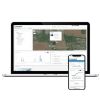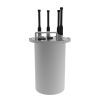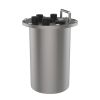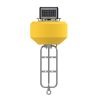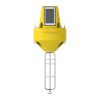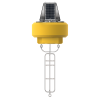NexSens CB-75 Data Buoy
Features
- Optimized for X3-SUB data logger with available 4G cellular or Iridium satellite telemetry
- Available with solar or blank top depending on battery type used in data logger
- Topside plate supports solar marine light, weather stations, and other sensors
- Expedited repair and warranty service
- Lifetime technical support
- More
The CB-75 Data Buoy is a compact, affordable, and easy to deploy platform for both water and atmospheric observations. At 21” (53.34cm) hull diameter and 40 lb. (18.14kg) weight, it’s ideally suited for tethered moorings. The buoy is designed to integrate the X3-SUB Submersible Data Logger, which includes external sensor ports to support weather stations, thermistor strings, multi-parameter sondes, Doppler current profilers, GPS, and other monitoring instruments.
Constructed of an inner core of cross-linked polyethylene foam with a tough polyurea skin, the CB-75 is designed for years of service. Select from a solar top with rechargeable battery pack for long-term deployments or a blank top with alkaline battery pack for short-term or seasonal applications. All electronics are housed in a quick-removable X3-SUB data logger package with wet-mateable connectors. A removeable instrument cage serves as counter-ballast and supports instrument mounting, while three 1.5” (3.81cm) pass-through holes facilitate cable routing of underwater sensors.
Available with integrated 4G LTE or Iridium satellite communications, the CB-75 Data Buoy sends data in real-time to the cloud-based WQData LIVE datacenter. In the Basic tier, this free service allows users to securely access and analyze data, as well as share data through an auto-report. Subscription-based tiers of WQData LIVE are also available for generating custom alarms, exporting data through an API or custom NDBC/GLOS formats, and providing a publicly-accessible version of the project website.
Hull Outer Diameter: 21” (53.34cm)
Hull Height: 13” (33.02cm)
Center Hole Inner Diameter: 5.5” (13.97cm)
Center Hole Height: 13" (33.02cm)
Pass-Through Hole Diameter: 1.5" (3.81cm)
Tower Height: 8.2” (20.83cm)
Solar Panels: 3x 4-watts (CB-75 only)
Weight: 28 lb. (12.70kg); 40 lb. (18.20kg) with X3-SUB
Net Buoyancy: 75 lb. (34.00kg)
Hull Material: Cross-linked polyethylene foam with polyurea coating & stainless steel deck
Hardware Material: 316 stainless steel, 304 stainless steel (lifting handles)
Tethering Attachments: 3x 3/8” eye nuts
In The News
Protecting Chicago's Lakefront: Freshwater Beach Monitoring
Thousands of people flock to the Great Lakes every year to enjoy the freshwater beaches along the coast. As an urban hub with over 2.5 million residents, beachfronts in Chicago have regular visitors as well as tourists that recreate in the bordering Lake Michigan. According to the Chicago Park District, it is estimated that more than 100,000 residents and visitors per day use Chicago’s Lakefront trail during summer weekends. Proximity to the Lake is not only a recreational activity for Chicagoans, but also a part of the city’s history due to its role in domestic and international shipping routes. In addition, the Lake serves as a drinking water source and as an essential climate regulator in the region that acts as a natural air conditioning affect.
Read MoreSource Water Monitoring in Albany, New York: Tracing Water Quality throughout Tributaries
Thousands of US cities pull their drinking water from natural source waters like reservoirs, rivers, and streams, making overall watershed health a key consideration for water providers. In Albany, New York, the Albany Department of Water and Water Supply delivers drinking water to over 100,000 residents as well as monitors and manages the larger drinking water supply watershed. Hannah Doherty, Environmental Specialist at the Albany Department of Water and Water Supply , spends her days working with a small team to monitor the drinking supply and the connected water bodies. Doherty explains, “We’re the first to encounter the water that ends up being the drinking water.
Read MoreWildfire Prevention in the Sierra Nevada Region with the Yuba Watershed Institute
Though recent wildfires have sparked new conversations about wildfire management and response, groups like the Yuba Watershed Institute have been monitoring the forests and water resources of the Sierra Nevada region for decades, managing approximately 5,000 acres of land with the Bureau of Land Management (BLM) and about 7,000 acres in private land partnerships. The goal of the Institute is to work with local communities and land agencies to improve watershed and forestry management through informed practices and public outreach. The goals of the Yuba Watershed Institute are three-fold: Improve the ability of fire suppression agencies like the California Department of Forestry and Fire Protection ( CAL FIRE ) and the US Forest Service.
Read More





















